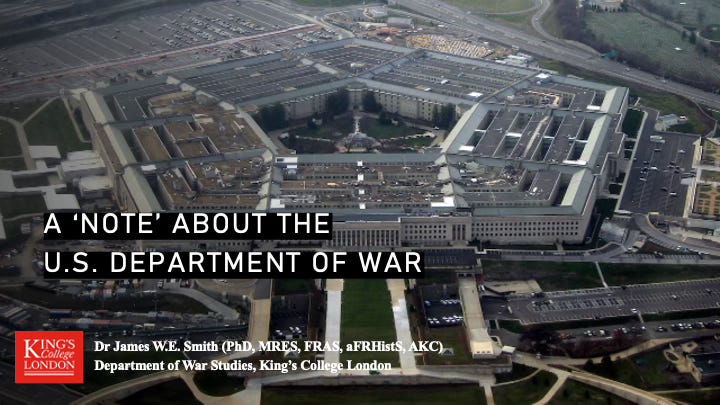A 'Note' about a U.S. Department of War.
Defence Unification contains divisions, issues and problems that few today understand or are equipped to handle: easily reopened with one false move. A Department of War is not the answer.
I spent fifteen years studying the relationship between organisation and the development, understanding and execution of strategy for national defence. It culminated in a PhD in ‘War and Strategic Studies’ from King’s College London, Department of War Studies. The PhD was titled: ‘Deconstructing the Seapower State: Britain, America and Defence Unification.’ That study included an entirely new analysis of the history of defence unification, the process by which the U.S. Department of Defense and U.K. Ministry of Defence were created. It was the first comprehensive narrative of defence unification, which went far beyond official accounts by utilising new, original documentary evidence, oral history, miles of declassified material, and more.
Having stated my credentials, this note reflects on the recent discussions in the United States regarding the renaming of the U.S. Department of Defense to the ‘Department of War’. I wish to point out, in brief, some salient points:
A significant force in the creation of a ‘Department of Defense’ was driven by the U.S. Army, which, in partnership with vocal advocates for an independent air force, believed that a unified defence department would be more effective in addressing their needs.
The U.S. Army, paranoid about its relatively poor performance and in particular civilian and military leadership in the Department of War—the bureaucratic control and command hub of the army––in the latter 19th and early 20th century, unlike the U.S. Navy, sought organisational reform as a way to explain away, rather than address fundamental issues it had.
The United States Navy was not represented in the Department of War; it had its own command and control in the form of the Department of the Navy prior to unification.
Unified defence was also partly driven by the experience of the Second World War and rapidly changing post-war circumstances. Crucially, lessons and insights from wartime, such as the collaboration between the services, were a key consideration in the creation of legal acts that culminated in the establishment of the new Department of Defense. The head of the U.S. Navy summarised to Congress: “unity of effort”, in short, matters like combined operations were vital to carry forward in a new organisational setup.
The Pentagon was initially designed to house the Department of War, before it became the Department of Defense. The U.S. Department of the Navy was reluctant to relocate to the Pentagon, as it would reduce the physical distance, oversight, and connection with the branches of the U.S. Government.
There were decades of debate and legal processes put in place to attempt to make defence work more effectively and efficiently in the defence of the United States, which could only take form within a unified department where all military services were considered ‘equal’.
The eventual title, ‘Department of Defense’ (1949), represented the mindset of a wartime generation, who, considering the new technological age, believed that efforts to fight for peace were vital, where lawmakers, military and citizens alike supported the title of the new department, which clearly sent the message of ‘peace by strength in our common defense of home’.
The U.S. Navy only supported unified defence after effectively campaigning for decades on the importance of equal Departments within a unified Department of Defense. They were later supported by U.S. Air Force who felt with the navy that any move, such as when former army General President Eisenhower attempted in the 1950s to change unified defence into an army approach in a revised ‘Department of War’ dominated organisation, would be devastating for effectiveness and efficiency. The need of a forum between the services to be able to execute their missions, roles and tasks was and is prime. The navy's view, in an effort to reduce toxic interservice rivalry, was that it was right to protect against one service overpowering or overshadowing another and equally too risky for the nation to have ‘blindness’ to strategic and tactical options of executing ‘war and peace’. Something that such ‘blindness’ would also hinder critical timely decision-making in the highest offices. Congress agreed by 1960.
In effect, calling the Department of Defense, ‘the Department of War’ could be interpreted as a retrograde step. One that is antithetical to the spirit, intent and law of unified defense, one bound Constitutionally to an army and navy, hand in hand. Rejecting over seventy years of organisational defense reform––not perfect with much right and wrong, bound up in law that would need to reversed or changed only by Congress––and equally operational experience before and during the DoD’s existence, would be a significant misstep in defence of the nation.
In short, although as innocent as some may consider a name change, the choice to call it ‘Department of Defense’ was because behind it was wisdom to send the message of effort of equal military services working together, than an image that any one service is more important than another.
Energy and effort should be directed to useful defence reform. Future debate should explore fundamental questions, rooted in sound policy and strategy, where the next steps in the journey of unified defence can take place. Reverting to a situation that, albeit only ‘sounds’ like one service dominating defense, is ignorant of the seabed to space defense of the 21st century. Notably, a world which did not exist when the Department of War was founded as a free-standing executive branch of the U.S Government.
Please look out for extended outputs on this topic in the near future.

